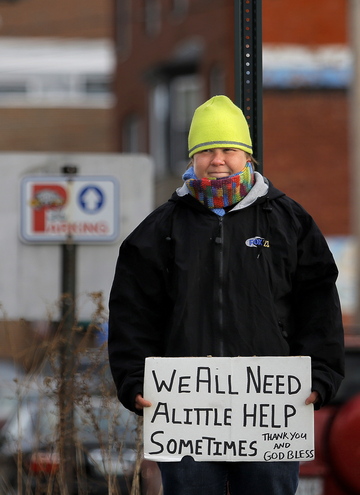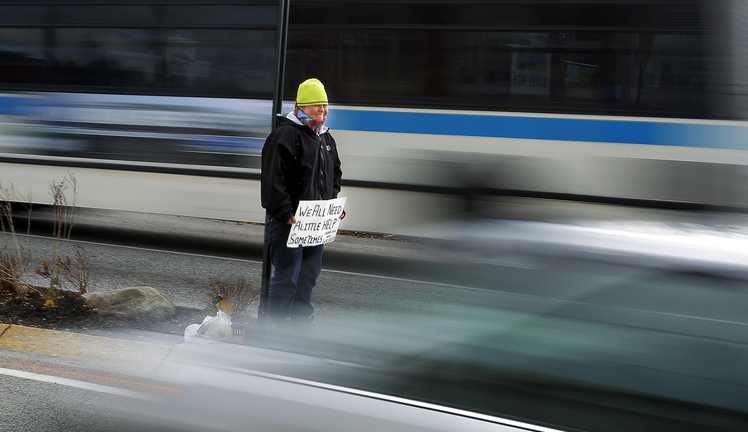Lawyers for the city defended Portland’s ban on panhandling or loitering on street medians during a one-day trial in federal court Tuesday, arguing that it’s a matter of public safety.
Opponents of the ordinance, meanwhile, urged U.S. District Judge George Singal to strike down the ban as an unconstitutional limit on free speech.
Singal is expected to rule in the coming weeks, but gave no indication Tuesday what he will decide.
The Portland City Council adopted the ban in July, saying it’s intended to protect the pedestrians who stand in medians and the people who drive past them.
“It’s amazing someone hasn’t been killed yet,” said Portland’s neighborhood prosecutor and lead attorney in the case, Trish McAllister.
The American Civil Liberties Union of Maine and the Boston-based law firm Goodwin Procter filed a lawsuit challenging the ordinance on behalf of three plaintiffs who want the right to stand in street medians, whether to hold signs and demonstrate or to ask for money.
The lawsuit claims the ban is an infringement on constitutionally protected free-speech rights.
“Very few municipalities have passed legislation as broadly as Portland has done,” said Kevin Martin, lead attorney for the plaintiffs.
The plaintiffs are Wells Staley-Mays and Michael Cutting, both political activists, and Alison Prior, who has stood on medians holding a sign asking for money. Their attorneys argued that the city’s ordinance prohibits them from getting their messages out to large numbers of people.
The attorneys pressed Portland Police Chief Michael Sauschuck on the reasons for the ban. Sauschuck and other city officials said it is needed to prevent accidents and injuries, but the plaintiffs argued that it was illegal to walk in front of or between vehicles even before the council enacted the ban.
In defending the ordinance as a safety issue, Portland’s attorneys presented testimony from Sauschuck, City Councilor Edward Suslovic, Public Services Director Michael Bobinsky and police Officer David Argetis.
McAllister cited more than 100 calls to police reporting people obstructing traffic, falling into streets and being belligerent. To underscore the danger to pedestrians, she showed several photographs of traffic signs in medians that had been damaged by cars, and reports on crashes in which vehicles had crossed medians.
Portland’s ordinance prohibits standing, sitting or staying in a median except to cross a street. A median is defined as any “paved or planted area of public right-of-way, dividing a street or highway into lanes according to the direction of travel.”
In October, the city announced that it will limit enforcement of the ban until the legal challenge is decided. It said police will enforce the ordinance only when people in medians appear to be drunk or under the influence of drugs.
The ordinance is essentially the same as one that the council turned down in 2012. After that vote, the number of panhandlers increased dramatically, said Suslovic, leading residents to complain.
“In all my years of elected service … this issue generated more public comment to me than any other issue I have dealt with,” said Suslovic, who chairs the City Council’s public safety committee, which recommended the ordinance to the council.
But Martin, the attorney for the plaintiffs, questioned the claim that panhandling has increased dramatically, noting that only 23 more incidents were reported in a five-month period of 2013 than in the same period of 2012.
He noted that city officials never considered a narrower ordinance to deal with the four intersections where most of the calls were generated, or the behavior – such as intoxication, obstruction of roads and disorderly conduct, which already were illegal – that led to the complaints.
“We think the city is motivated in some way to get panhandlers out of sight,” Martin said.
Bobinsky testified that the city has about 180 miles of sidewalks, 1,000 acres of public open spaces and eight to 12 miles of public trails, where political speech and panhandling are still allowed.
All three plaintiffs, however, contended that those places are not as effective for communicating their messages – whether opposing U.S. military intervention abroad or asking for help – as street medians.
“If people can’t see you or have a hard time donating to you, they just don’t,” Prior said.
Singal questioned whether receiving fewer donations is an infringement on free speech. He also questioned whether public safety threats are reduced by moving people from medians to sidewalks.
One of the key criteria for whether the ordinance violates the First Amendment is whether it targets a specific type of speech, Singal said.
Both sides agree that the language of the ordinance is content-neutral, meaning it affects everyone equally.
Sauschuck said police use discretion in enforcing it. Police allow people to put political and campaign signs on medians, and don’t enforce the ordinance in Boothby Square, where a wide, grassy strip technically meets the definition of a street median.
Also, state law allows political and hand-held signs in medians for seven weeks around Election Day.
“I’m scratching my head,” Singal said.
Both sides have two weeks to prepare responses to Tuesday’s proceedings. Once those are filed, both sides will have two more weeks to file rebuttals before Singal makes his ruling.
Randy Billings can be contacted at 791-6346 or at:rbillings@pressherald.comTwitter: @randybillings
Send questions/comments to the editors.




